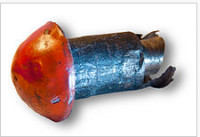








A rivet is a permanent mechanical fastener. Before being installed, a rivet consists of a smooth cylindrical shaft with a head on one end. The end opposite the head is called the buck-tail. On installation the rivet is placed in a punched or drilled hole, and the tail is upset, or bucked (i.e., deformed), so that it expands to about 1.5 times the original shaft diameter, holding the rivet in place. To distinguish between the two ends of the rivet, the original head is called the factory head and the deformed end is called the shop head or buck-tail.
The humble rivet may be small,but is has a lot to answer for-including,quite possibly,the sinking of the Titanic.Rivets have been in widespread use for thousands of years but,because engineers now depend on them to secure boats,bridges,aircraft and other more complex constructions ,their reliability has become paramount.
Rivet holes have been found in Egyptian spearheads dating back to the Naqada culture of between 4400 and 3000 B.C.E. Archeologists have also uncovered many bronze Age swords and daggers with rivet holes where the handles would have been.The rivets themselves were essentially short rods of metal,which metalworkers hammered into a pre-drilled hole on one side and deformed on the other to hold them in place.Today,a wide variety of rivets exist,as do .specialized tools for installing them.
The extensive use of rivets in modern engineering and architecture has,inevitably,increased the likelihood of the odd one or two coming unstuck.Materials scientists have blamed rivets for RMS Titanic's infamous descent in 1912,killing over 1,500 people.